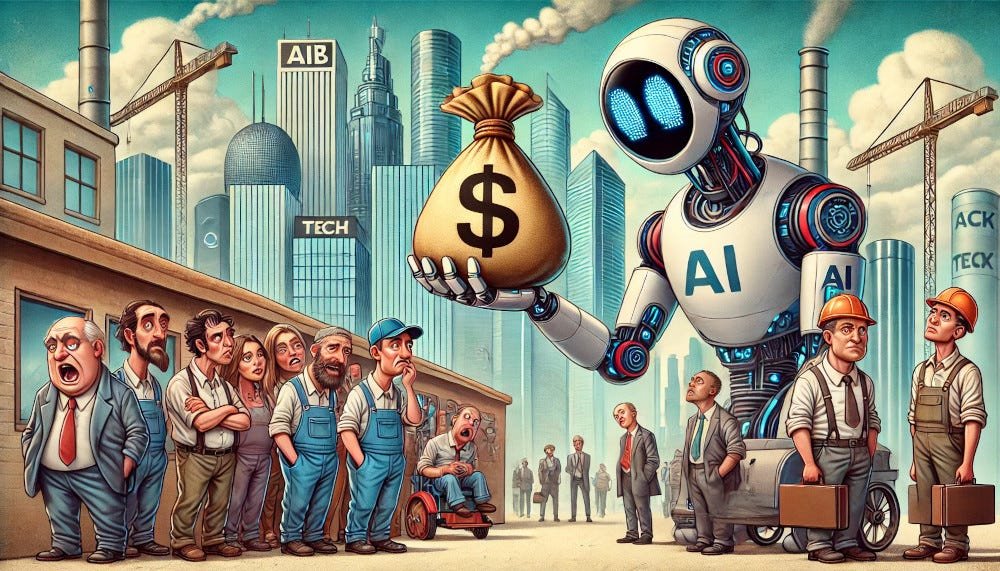Why in the News?
- Geoffrey Hinton, a Nobel Laureate and pioneer in Artificial Intelligence (AI), recently warned that AI may make a few people extremely wealthy while leaving the majority poorer.
- Economists are drawing parallels between this phenomenon and the concept of the Engels’ Pause, where productivity growth does not immediately translate into better living standards.
- Global research reports, along with mass layoffs in technology firms, indicate that the benefits of AI may not be widely shared in the short run.
Key Highlights
- Understanding Engels’ Pause
- Engels’ Pause refers to a historical period in 19th-century Britain where industrial output expanded rapidly, but wages stagnated and inequality widened.
- The concept was developed by Robert Allen and named after Friedrich Engels, who documented poor working conditions of the time.
- The lesson from history is that productivity gains alone do not guarantee welfare improvements unless institutions adapt to share benefits fairly.
- AI as a General-Purpose Technology (GPT)
- AI is comparable to earlier general-purpose technologies (GPTs) such as steam power, electricity, and the Internet, which transformed multiple industries.
- It reduces the cost of prediction and decision-making, thereby reshaping business processes across sectors.
- Historically, GPTs have created long-term prosperity but often caused short-term disruption, requiring skill upgrades, institutional changes, and policy reforms.
- Indicators of a Modern Engels’ Pause in AI Economy
- Productivity improvements from AI tools are visible in service sectors such as call centres, but workers are not seeing proportional wage growth.
- The cost of complements such as reskilling, certifications, data access, and cloud infrastructure is rising, making it harder for individuals and firms to keep pace.
- The gains from AI are highly concentrated in advanced economies and large corporations, thereby deepening global inequality.
- Job transformation and displacement are already occurring in healthcare, education, and public administration, where AI is reshaping or replacing traditional roles.
- Historical and Contemporary Lessons
- In the Gilded Age of the United States, productivity rose without corresponding wage growth, which led to social unrest and eventually labour reforms and welfare states.
- The lesson is that growth without redistribution results in inequality, while reforms and social safety nets ensure broad-based prosperity.
- Today’s policymakers must design AI governance mechanisms to prevent welfare stagnation despite rapid technological progress.
- Global Models and Policy Options
- Singapore’s SkillsFuture programme shows how continuous education and upskilling can help workers remain relevant in a changing economy.
- The Mohamed bin Zayed University of Artificial Intelligence (MBZUAI) in Abu Dhabi is an example of building specialized human capital for future needs.
- Redistribution of AI-generated wealth can be attempted through Universal Basic Income (UBI) and robot taxes.
- Open-source initiatives such as ai in the UAE demonstrate how treating AI infrastructure as a public good can democratize access.
Implications
- Rising Inequality: Without policy intervention, the concentration of AI wealth in a few countries and corporations will worsen the income gap both within and between nations.
- Labour Market Disruption: Younger workers, low-skilled employees, and those in repetitive roles are the most vulnerable to displacement, leading to risks of structural unemployment.
- Global Technological Divide: Advanced economies are more likely to harness AI benefits quickly, while developing economies risk falling further behind as technology consumers rather than technology producers.
- Need for Institutional Reform: Welfare systems, labour laws, and education models must be updated to handle the challenges of AI-driven disruption. Without these reforms, welfare stagnation may persist.
- Opportunity for Social Transformation: If governed effectively, AI can lower the costs of healthcare, education, and clean energy, thereby delivering immediate welfare benefits, especially in developing nations.
Challenges and Way Forward
| Challenges | Way Forward |
| Productivity gains are not translating into higher wages for workers. | Introduce policies that ensure fair distribution of AI-led profits, including wage-linked incentives. |
| The high cost of training, cloud infrastructure, and certifications excludes many workers and firms. | Provide public funding for reskilling, digital subsidies, and affordable AI infrastructure. |
| AI wealth is concentrated in a handful of global firms and countries. | Promote open-source AI, encourage domestic innovation, and strengthen multilateral technology agreements. |
| Risk of widespread job displacement across key service sectors. | Strengthen social safety nets, experiment with UBI, and create jobs in AI-complementary sectors. |
| Lack of coordinated AI governance mechanisms globally. | Establish global AI norms through G20, IMF, WTO to ensure fairness, accountability, and transparency. |
Conclusion
The idea of an AI-driven Engels’ Pause highlights the risk of productivity growth without corresponding welfare gains. History shows that unchecked inequality leads to social unrest, while reforms and redistribution can convert technological revolutions into welfare revolutions. The future of AI will depend less on its technical capabilities and more on the governance choices made by governments and institutions.
| Ensure IAS Mains Question
Q. The concept of an Engels’ Pause highlights the gap between productivity growth and welfare gains. In the context of Artificial Intelligence, critically examine how India can avoid such a pause and ensure inclusive development. (250 words) |
| Ensure IAS Prelims Question
Q. With reference to the concept of Engels’ Pause, consider the following statements: 1. It refers to a historical phase in Britain when productivity increased rapidly but real wages remained stagnant. 2. The term was coined by Friedrich Engels in the 19th century. 3. In the modern era, the term is applied to situations where new technologies raise output but do not immediately improve welfare. Which of the statements given above is/are correct? a) 1 and 2 only b) 2 and 3 only c) 1 and 3 only d) 1, 2 and 3 Answer: c) 1 and 3 only Explanation: Statement 1 is correct: Engels’ Pause occurred in Britain during the Industrial Revolution, with high productivity but stagnant wages. Statement 2 is incorrect: The term was coined by Robert Allen, not by Friedrich Engels. Statement 3 is correct: It is now applied to the AI economy, where productivity gains may not immediately translate into welfare improvements. |
|
Also Read |
|
| UPSC Foundation Course | UPSC Daily Current Affairs |
| UPSC Monthly Magazine | CSAT Foundation Course |
| Free MCQs for UPSC Prelims | UPSC Test Series |
| ENSURE IAS NOTES | Our Booklist |





